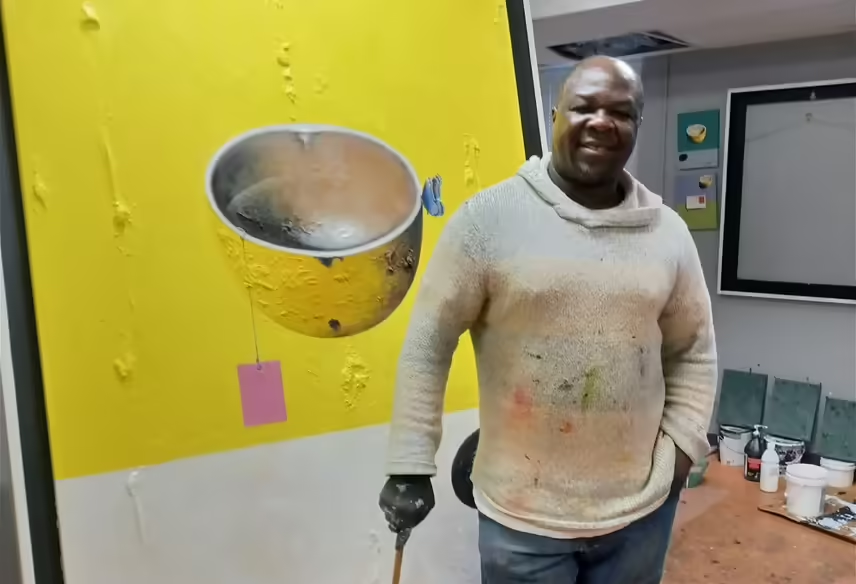The ‘Father of the Flying Calabash’ feels at home in Columbus was originally published by Matter News, a local news nonprofit in Columbus, Ohio.
“I have lived in many places,” Talle Bamazi said. “But I love Columbus, Ohio, and will live and die here.”
I’m sitting in Bamazi’s studio on Bryden Avenue and he’s showing me several paintings he is working on for an upcoming exhibit in Togo, West Africa, the country in which he was born. He is fresh off a successful retrospective at the Schumacher Gallery at Capital University. Bamazi is not one to sit idle.
The artist is the self-proclaimed “Father of the Flying Calabash,” the calabash being an important object in African culture – a bowl representing sharing, fertility and community.
“For me it is a connection to ancestry, a bridge between the living and the dead,” he said.
Bamazi’s son died in a car accident in May 2019 at age 19. Stunned by pain and grief, Bamazi ceased painting. “I couldn’t go on,” he said. Not long after, Bamazi’s son appeared at the window in a vision, accompanied by a flying calabash.
“Why are you grieving?” he asked his father. “You had me for 19 years. You should be happy. Pick up your palette and continue painting, celebrate!” With those words, his son flew out the window along with the calabash.
“I knew it was real. It wasn’t a dream,” Bamazi said. “He was here. I picked up my palette and started to paint again.”
Many of the large, colorful paintings that emerged as the artist resumed working featured a solitary calabash floating in space, the otherworldly nature of the image inviting viewers to speculate on what they are seeing.
Though each of these paintings are, in part, an homage to his son, Bamazi is happy to have his audience take with them what they will.
“My paintings are not what many people think of when they think of African art,” he said. “They might think of colorful, flat colors that are decorative, which does describe many African artists. But my paintings are more figurative, with a definite surrealistic influence.”
Talle Bamazi“I think each painting has helped me understand grief and death. It has made me a better person. And I hope some of that wisdom is communicated to the viewer.”
Bamazi didn’t know a word of English when he arrived in the U.S. in 1995. But he learned quickly, eventually finding his way to the Art Students League of New York City, where he further immersed himself in the culture of this country. Bamazi then went on to continue his education at the New York Academy, where he graduated with a master’s degree.
Upon arriving in Columbus, Talle founded a gallery called Kabiye Impact Contemporary African Art (KIACA) in 2003. He wanted to give a voice to fellow African artists who struggled to have their art viewed and appreciated.
More recently, Talle has been working on a 203-piece series called “Dwell” that honors the calabash. “I think each painting has helped me understand grief and death,” he said. “It has made me a better person. And I hope some of that wisdom is communicated to the viewer.”
These works follow the arrival of Covid and the ensuing lockdown, which crept into a series of Bamazi’s paintings, with the multi-pronged virus sometimes appearing alongside human skulls or vaccine bottles. Unofficially dubbed “The Year of Sorrow,” the series serves as a permanent and moving memorial to the millions who died from the virus, as well as to those who survived.
To experience the power of Bamazi’s paintings in person is powerful. We are fortunate to have him in our midst.
“My wife and I visited a few places, looking for a place to settle down,” he said. “And in the end, Columbus was our choice. There was something in the air with the arts scene and we felt at home. I hope to never leave.”
